Defining culture as a term is quite important, and cultural tourism is a complex activity to manage and understand. Since 1968, culture tourism has been understood as the preservation and exploitation of cultural heritage (UNESCO, 1968), which the International Council on Monuments and Sites (ICOMOS Tourism Committee, 1976) also identifies as a source of economic benefit and cultural education. International organisations have also been involved in findings about culture and tourism. For example, the Organization for Economic Co-operation and Development (OECD) has established policies to face impacts, while the Organization of American States (OAS) has managed the relationship of culture to tourism products.
Numerous disciplines, including sociology (Buck, 1978), geography (Linhart, 1980) and agriculture (Janzen, 1973), have continuously focused on culture and tourism. The main trends in the 1990s included topics such as heritage (Beeho & Prentice, 1997; Edwards & Llurdés i Coit, 1996; Moscardo, 1996; Nuryanti, 1996; Peleggi, 1996; Silberberg, 1995; van der Borg et al., 1996); production and consumption (Richards, 1996); urbanism (Chang et al., 1996); art (Herbert, 1996); ethnicity (Moscardo & Pearce, 1999); and authenticity (Cohen, 1988; McIntosh & Prentice, 1999), among others.
The new century has brought along interest in the actors involved in cultural tourism, such as residents, which appear in studies that analyse perceptions (Besculides et al., 2002; Gibson & Davidson, 2004), relationships between tourists and Aboriginal people (McIntosh, 2004; Ryan & Huyton, 2002); the community-based aspect (MacDonald & Jolliffe, 2003; Ying & Zhou, 2007), the motivation of tourists (Fernández et al., 2016; Richards, 2002), visitors’ experiences (Rojas & Camarero, 2008), visitor-friendliness (Russo & van der Borg, 2002), valorisation of heritage (Greffe, 2004) and heritage management (Landford, 2009; Mckercher et al., 2004), among others.
At present, early expressions of creativity are also emerging (Prentice & Andersen, 2003; Richards & Wilson, 2006) that consider the impacts in Aborigine communities (Chang, 2006; Dyer et al., 2003; Medina, 2003), as well as papers about culture and economic impacts (Bunten, 2008; Herrero et al., 2006), genealogical endeavours (McCain & Ray, 2003); food experiences (Quan & Wang, 2004; Sims, 2009); imagined recognition (Prentice, 2004); and authenticity (Chhabra, 2008; Cole, 2007; Wang, 2007), to point to but a few areas. In fact, the term cultural tourism has a high degree of subjectivity, because what constitutes for some people as cultural tourism, for others is only pleasure (Mallor et al., 2013). Starting from a European background, where all movement is cultural tourism (De Cluzeau, 2000) as a consequence of the value of heritage (Richards, 2006), many authors have integrated the concept into their research (Hughes, 1996; Richards, 1996; World Tourism Organization, 2005).
This article aims to analyse the scientific production on cultural tourism published between 2010 and 2019 in Europe using bibliometric indicators. The remainder of this paper is structured as follows: After the present introduction, the second section addresses the theoretical framework, in which the perspectives on the term cultural tourism are reviewed, as well as trends and authors on this subject. The third section develops the methodological procedures; after a brief framework on bibliometric analysis, the criteria for examination of the information are presented. Fourth, the bibliometric analysis of Web of Science (WoS) and Scopus publications are presented. VOSviewer was used for encoding and to produce graphics to illustrate relevant citations, authors’ connections, associated terms and topic groups. Finally, the conclusion of the research resumes the key categories identified in the trends of cultural tourism publications from 2010 to 2019.
Research related to culture and tourism started to appear around the 1970s. The General Conference of the United Nations in 1968 named “cultural tourism” among the activities in programmes for the preservation and exploitation of cultural heritage (UNESCO, 1968). The publication of the Cultural Tourism Charter in 1976 tried to define and narrow down the conditions to drive this sort of tourism (ICOMOS Tourism Committee, 1976). Brameld and Matsuyama wrote about tourism as cultural learning in 1978, and one year later, in 1979, the Draft Declaration on Cultural Tourism was published in Quebec, which was useful for the report of the UNWTO in 1980 (Courtmanche, 1979).
In the ’80s, tourism research increased around the world and cultural tourism remained a part of that growth (Richards & Munsters, 2010). The OECD headed the field in tourism policy analysis, while the OAS approached research on cultural heritage and tourism products. Studies of major regions of the world were also included, for example, Thorburn (1986) investigated cultural heritage as an incidence of tourism in destinations such as Europe.
In the ’90s, research addressing studies of the international cultural tourism market emerged (e.g., the Association for Leisure and Tourism Education), in addition to studies that used anthropology to approach the pros and cons of the relationship between host and guests, the growth of cultural tourism in Europe (Richards, 1996) and activities in world heritage cultural sites (Garfield, 1993). This was also when the term “heritage tourism” began to be used in the UK in relation to this topic.
This does not mean that cultural tourism itself was born in the 20th century. The Grand Tour as among the first demonstrations of tourism activities in the 17th century (Feifer, 1985; Hibbert, 1969; Towner, 1985) and encompassed educational aims with a huge cultural component, although this was in the 18th century when Grand Tourists expanded to the “bourgeois notion of the universal aesthetic of cultural manifestation” (Richards, 1996).
Research streams are continuously changing and, in parallel, the topic of cultural tourism has been influenced by various disciplines. Sociology has been used in the examination of religious tourism (Rinschede, 1992). Geography and anthropology have been associated with the paradigm of mobilities (Ashworth & Page, 2011; Edensor, 2007; Sheller & Urry, 2006; Tribe, 2010) where the influence of transportation and technology studies has emerged in social science. Agriculture has been introduced as a consequence of the local food experience and the relationship between sustainable tourism and the value chain of organic food (Sims, 2009). In the fields of biology, psychology and sports, tourism has been studied in terms of human well-being (Vöelker & Kistemann, 2011). Communication was also immersed as a result of human activity and the confluence with geography in geo-located studies (Hawelka et al., 2014) or marketing analysis (Braun et al., 2013).
Innovations have been strongly present in tourism since open access to the web. In recent years the role of social media has been included in highly regarded research, such as the studies by Xiang and Gretzel (2010), Sparks and Browning (2011) and Leung et al. (2013), among others. A review of innovation research in tourism was also set forth by Hjalager (2010), along with new approaches to accommodation in the tourism sector (Guttentag, 2015). Technological disruptions such as artificial intelligence (Buhalis et al., 2019), virtual reality (Flavián et al., 2019) and information technology (Neidhardt & Werthner, 2018) have also been discussed in relation to tourism. Events such as the COVID-19 pandemic sharply changed the evolution of tourism, which turned the attention of most studies to disaster management (Ritchie & Jiang, 2019) and resilience (Zheng et al., 2021).
Despite the importance of cultural tourism, there have been few rigorous bibliometric analyses of research on the topic. The bibliometric analysis incorporates the systematic quantitative analysis of theoretical literature to measure scientific progress (Raan, 2004; Ramos-Rodríguez & Ruíz-Navarro, 2004), using techniques such as citation analysis, co-citation analysis and content analysis (Ramos-Rodríguez & Ruíz-Navarro, 2004; Shilbury, 2011). In line with this description, this paper reviews the evolution of research on cultural tourism to identify trends and patterns.
Through the analysis of 625 WoS articles and 765 Scopus articles, this publication provides a significant overview of the terms involved or related to cultural tourism, as well as evidence of the paradigm shifts in which this term has been involved. The first contribution is the identification of the most cited authors, and the second contribution is the illustration of co-author networks. Finally, the study highlights the most outstanding topics through co-occurrence analysis of the themes that have been considered from 2010 to 2019.
Bibliometric studies in the tourism context have been used by Hall (2011) to evaluate journal ranking and research quality. Similarly, Benckendorff and Zehrer (2013) analysed tourism research such as Koseoglu et al. (2016). Other authors have highlighted sustainable tourism (Ruhanen et al., 2015; Serrano et al., 2019), and Seguí-Amortegui et al. (2019) also conducted this type of study, associating sustainability and competitiveness. Other authors, meanwhile, have reviewed journals of tourism using this methodology (Merigó et al., 2019; Mulet-Forteza et al., 2019; Vishwakarma et al., 2019).
A comparison between the papers in Scopus and WoS on wine tourism was conducted by Sánchez et al. (2017), and Okumus et al. (2018) evaluated gastronomy. Tourism crisis and disaster management was subjected to bibliometric analysis by Jiang et al. (2019), while De la Hoz-Correa and Muñoz-Leiva (2018) examined medical tourism research. Hospitality research was assessed by Mulet-Fortaleza et al. (2019). To sum up, there have been a few studies in the field of tourism that use bibliometric analysis, but they do not include cultural tourism as the main topic.
This study followed a several steps to yield a bibliometric analysis of the evolution of cultural tourism as a research subject; these steps are outlined in Table 1. First, cultural tourism was defined as a keyword of the research. Subsequently, the WoS and Scopus databases were reviewed, introducing some adjustments to the criteria to refine the research, such as limiting the study to publications from 2010 to 2019. Then the countries filter was applied to consider only the territory of Europe. This process considered keywords in the title, abstracts and keywords of the papers.
Methodology of the research
| STAGE | DESCRIPTION |
|---|---|
| Step 1 Definition of the work field | Cultural tourism |
| Step 2 Selection of the databases | Web of Science Scopus |
| Step 3 Adjustment of research criteria |
|
| Step 4 Codification of collected material |
|
| Step 5 Examination of the information | Analysis and discussion of the results |
The first database reviewed was WoS, where the research criteria were set out as “cultural tourism”, applying the filter of publication years from 2010 to 2019 and European countries excluding Russia and Turkey. This yielded a total of 625 publications that included articles, proceeding papers, book chapters, books, review articles and editorial material.
As Figure 1 illustrates, the field with the most articles is “Hospitality Leisure Sport Tourism”, with 45% of the results, and the least addressed is “Social Sciences Interdisciplinary”. As a whole, services, business and management comprise about 55% of the documents; these involve the performance of the individual in tourism activities and the significant contributions to a region’s economy. The environment and geography account for more than a quarter of the items retrieved; these studies covered the vital link between human beings and the ecosystem.
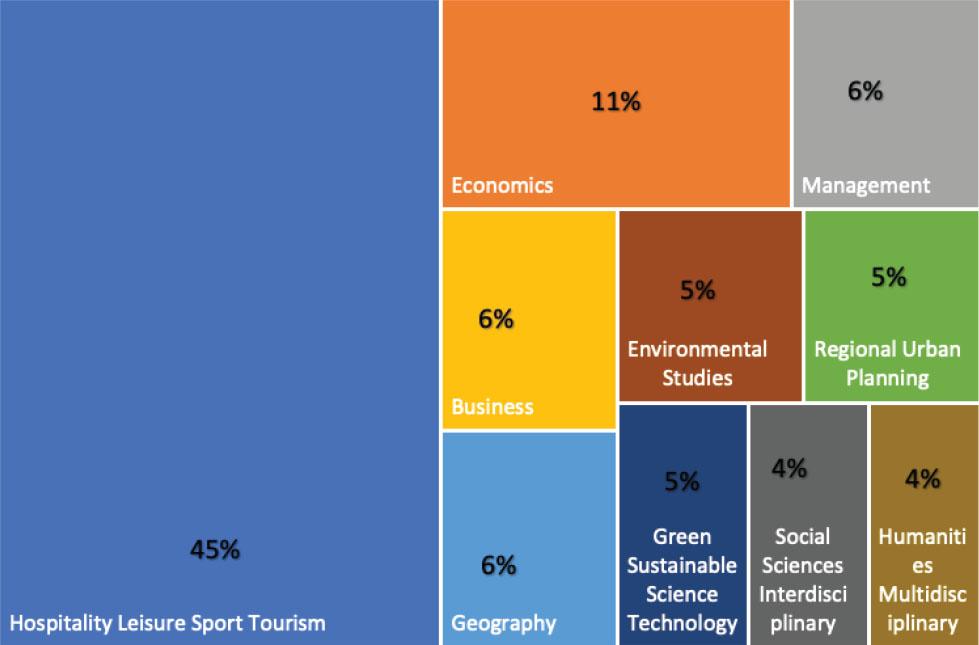
Main areas of publication on cultural tourism in the Web of Science database from 2010 to 2019.
After applying the filters mentioned above to a group of 3,359 documents about cultural tourism from Scopus, the applied advance research criteria were applied: “cultural tourism” was limited to the publication years between 2010 and 2019, and was limited to European countries. This yielded 763 documents.
Most of the sources of publication in Scopus reveal the dominance of the English language in tourism research, and it should also be noted that there were just a few items in Portuguese and other European or Asian languages. In WoS, the results were somewhat similar and, despite having two important Spanish journals (Cuadernos de Turismo and Pasos), most of the articles were written in English. Figure 2 illustrates the main sources of publication in Scopus on cultural tourism; these tend to be journals that involve business and management. Almost two quarters focus on the social sciences, while the least common source of items included interdisciplinary areas.
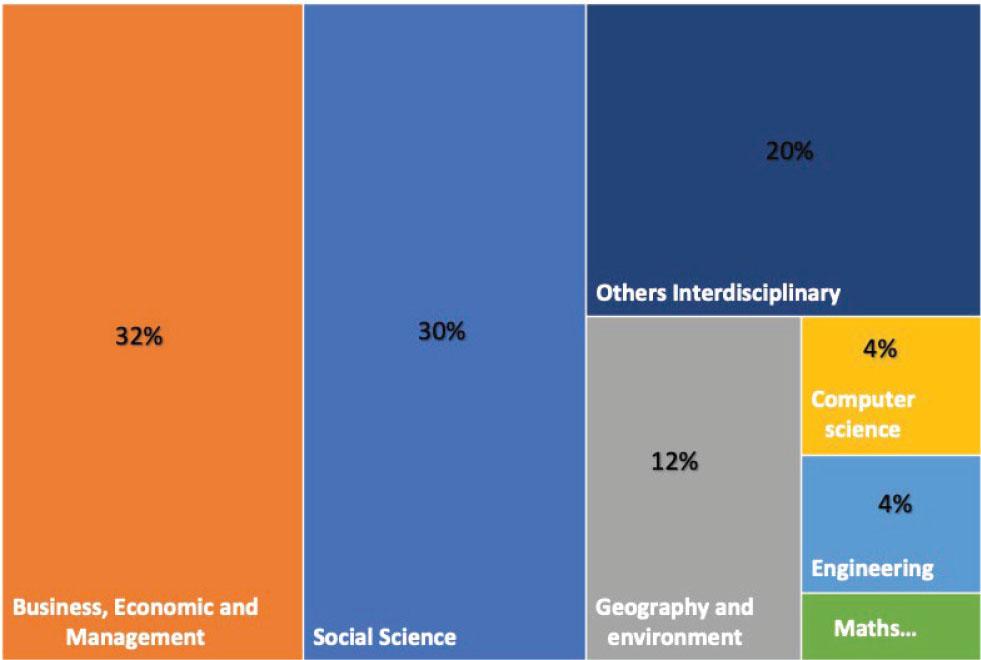
Main areas of publication on cultural tourism in the Scopus database from 2010 to 2019.
Looking at the number of documents by year, it can be demonstrated that the quantity of research on cultural tourism has been increasing in the last decade according to the Scopus Database, beginning with 36 and reaching 152 articles in 2019; meanwhile, in WoS the same trend also appears, as the quantity goes up from 38 in 2010 and more than doubles to 111 in 2019.
Much more relevant, however, is the average number of citations, which reaches 10.88 per item in WoS, while the total number of times cited is 5,707, mostly in the Hospitality Leisure Sport Tourism category. In Scopus, the number of citations is higher, reaching 10,577; the average number of citations is thus 13.82 per item. The comparison of the two databases can be seen in Figure 3.
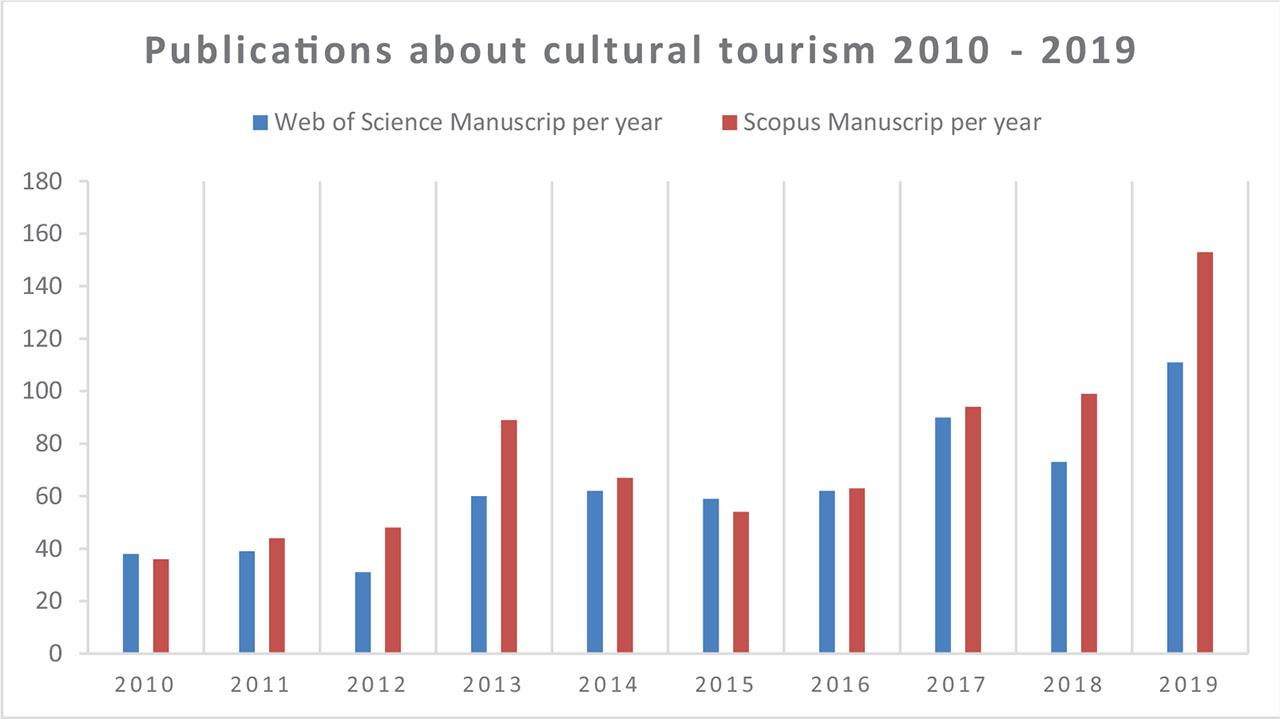
Publications about cultural tourism in Web of Science and Scopus
When analysing countries where journals are published in cultural tourism, the leader is Spain with a total of 139 and 183 in WoS and Scopus, respectively, for which the affiliation is Spanish universities, although most of the articles are written in English. Although France is not included in the top 10 countries, Italy and the United Kingdom also have a significant presence; this is illustrated in Figure 4.
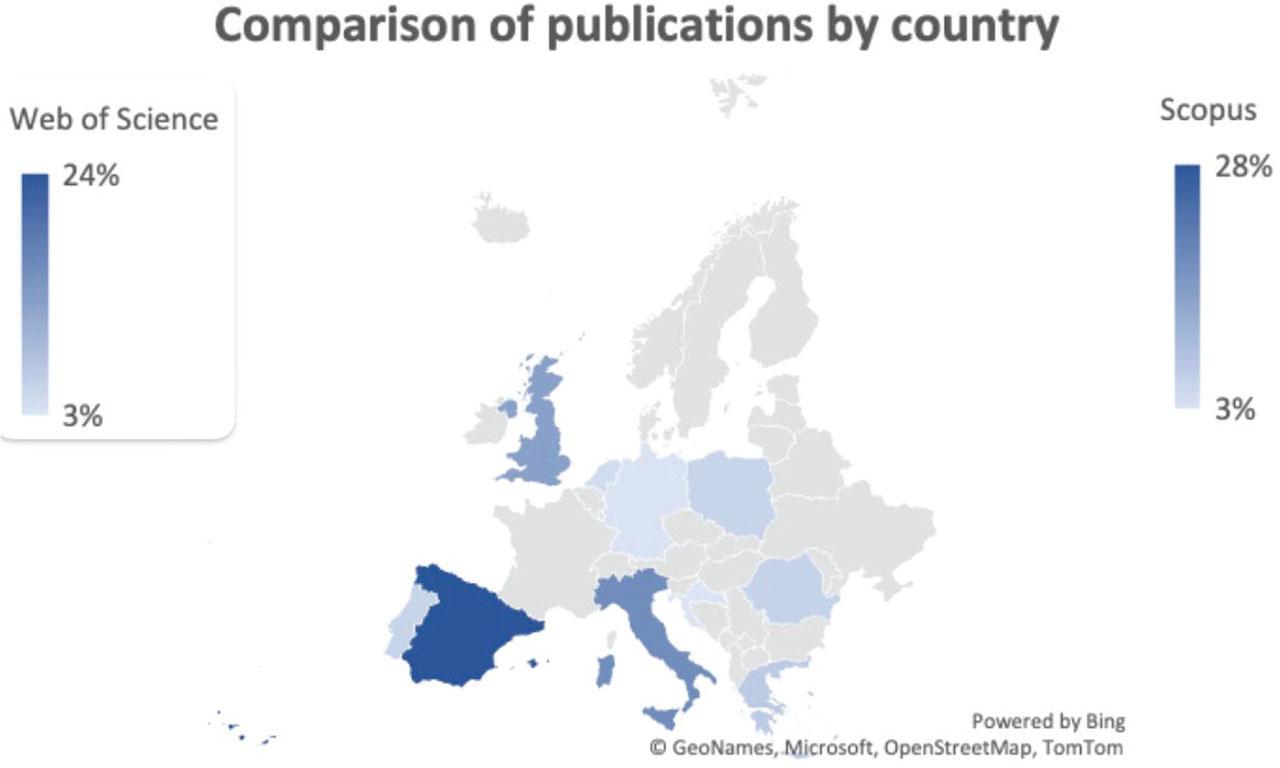
Comparison of publications by country, based on Web of Science and Scopus
Figure 5 depicts a comparison of the 10 authors with the most publications between 2010 and 2019 in the WoS and Scopus database. The notable authors are not the same in the two databases, although Martínez-Perez stands out as the most prolific in both WoS and Scopus. Elche and Richards also have many publications. Although Pulido-Fernández has the largest number of publications in WoS, in Scopus, Pulido-Fernández is just present within the last position of the top 10. The relationship between the number of publications and the citations of those authors is not relative.
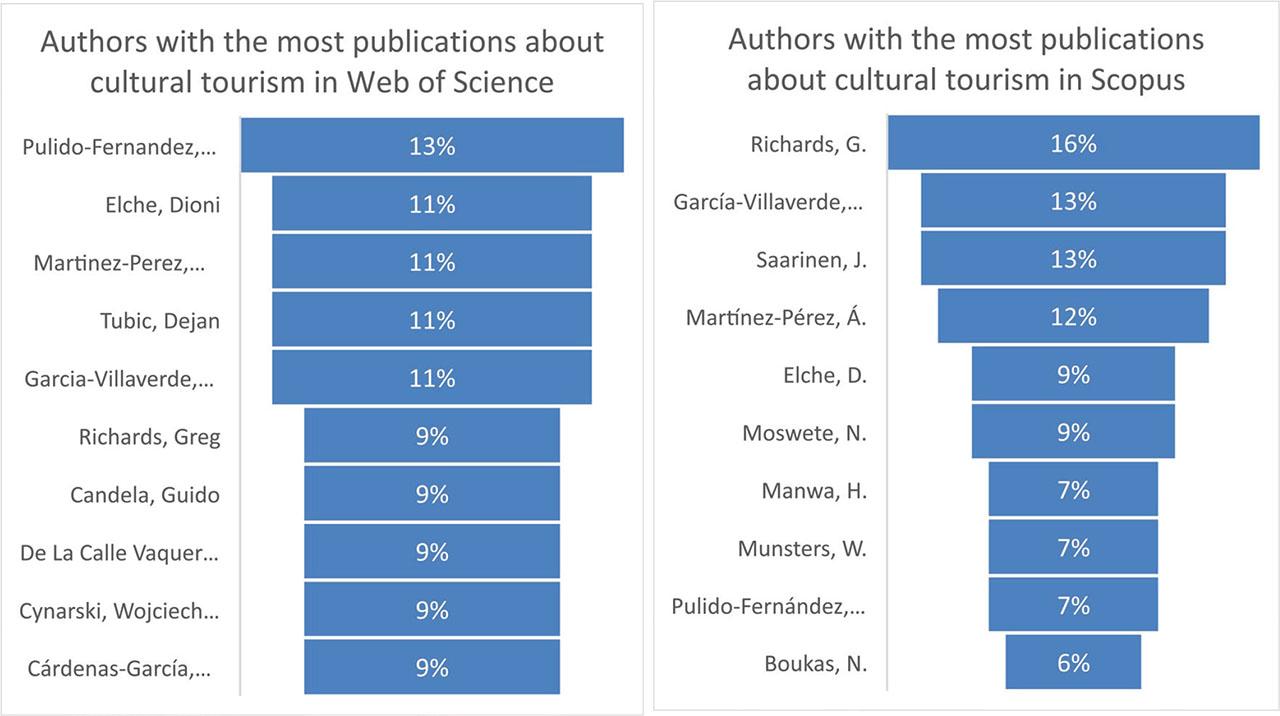
Authors with the most publications between 2010 to 2019 in Web of Science and Scopus
Figure 6 illustrates the bibliographic coupling analysis in WoS; this is when two works reference a common third document in their bibliographies and it indicates the networks of co-citation in publications on cultural tourism. Richards and Kolar were the outstanding authors, likely because they authored the oldest documents in the group so they have had more possibilities of being cited than new ones. Even so, Dieck et al. (2018) on the topic of augmented reality, written in 2018, has also reached a significant impact. The research on social capital and innovation by Martinez-Perez in 2016 also has a noteworthy number of citations.

Bibliographic coupling analysis map of documents on the theme of cultural tourism in WoS
Figure 7 illustrates the most cited authors in the documents and their networks of influence on others in the Scopus database based on bibliographic coupling. Richards’ publication about creativity and tourism, written in 2011, clearly apears to be the most relevant. Kolar is also highlighted for research on authenticity. In a lesser range, but still cited more than 100 times, Cuccia in 2011 wrote about seasonality and Salazar wrote about community-based cultural tourism.
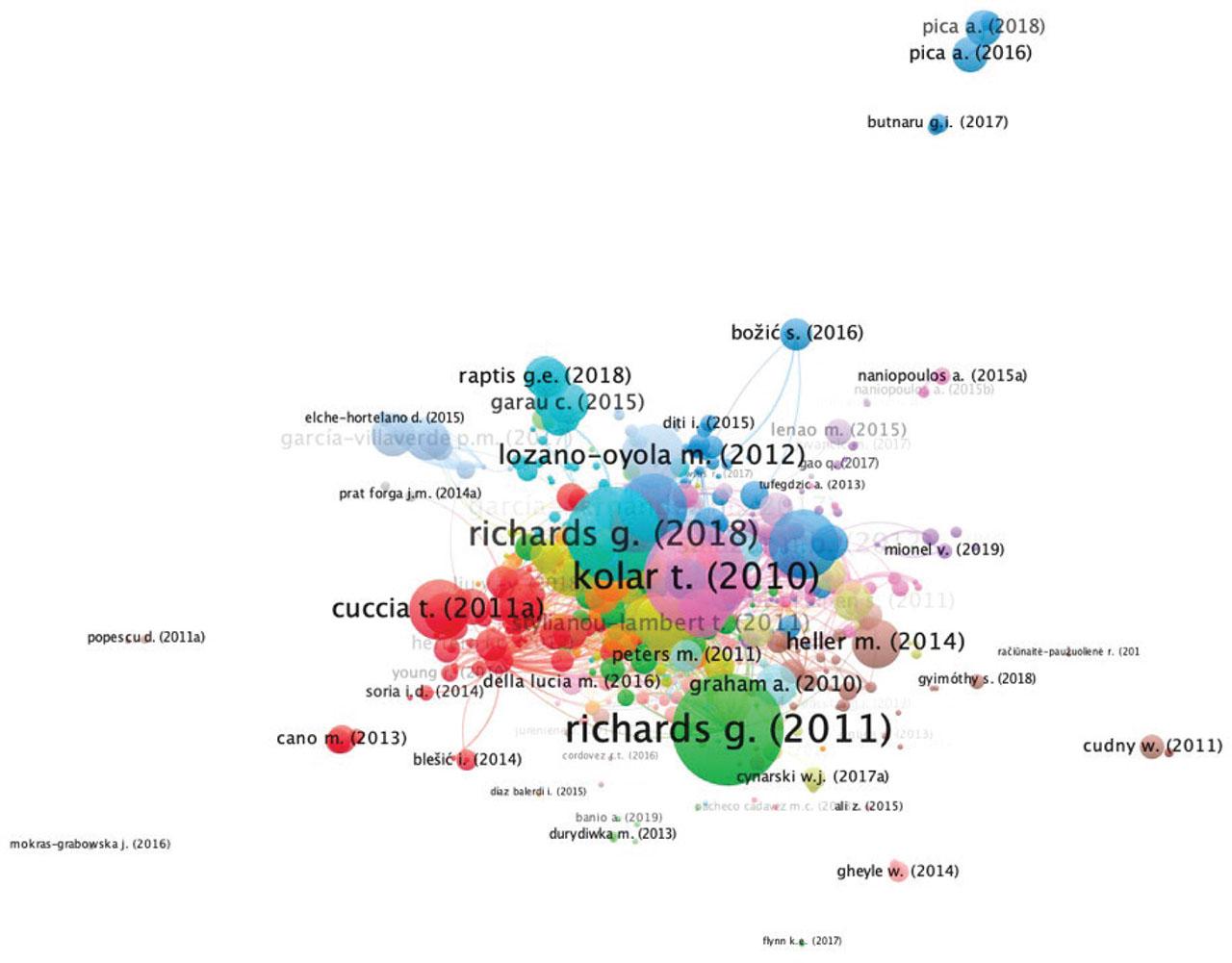
Bibliographic coupling analysis map of documents on the theme of cultural tourism in Scopus
Figure 8 represents an analysis of the most cited documents about cultural tourism in WoS; the colours differentiate topics in the research—that is, technology in cultural tourism is purple, creative tourism is red, world heritage is green and authenticity is orange.
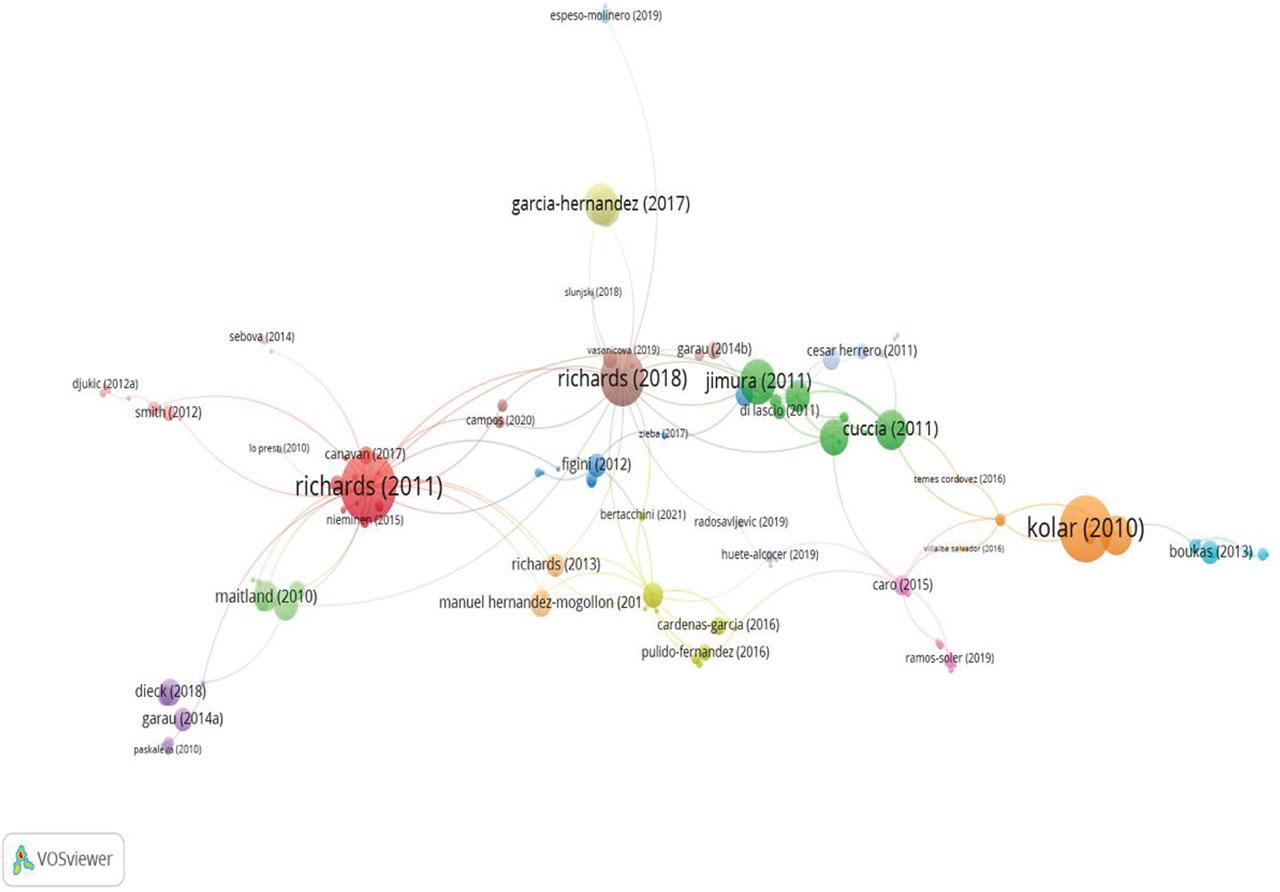
Bibliographic analysis of most cited documents in WoS
Table 2 lists the authors and relevant topics related to cultural tourism in the decade 2010–2019 in WoS. The results can help us to see that the need to produce experience in the practice of cultural tourism has led to new trends and global patterns linked to the activity, such as augmented reality.
Most Cited Authors Writing About Cultural Tourism in Web of Science
| Authors | Citations | Year | Cultural Tourism |
|---|---|---|---|
| Kolar, T. | 401 | 2010 | Authenticity |
| Richards, G. | 435 | 2011 | Creativity and tourism |
| Figini, P. | 54 | 2012 | Seasonality |
| Garau, C. | 111 | 2014 | Smart practices to cultural destination |
| García-Hernández, M. et al | 155 | 2017 | Cultural heritage and urban tourism |
| Richards, G. | 281 | 2018 | Trends of cultural tourism |
| Dieck, T. | 72 | 2018 | Experience with augmented reality |
Figure 9 depicts the most cited authors in Scopus, where Richards stands out twice with an older publication about creativity tourism and a more recent one on trends in cultural tourism. Another point to clarify is the new grouping of research: the red cluster includes sustainability topics and the yellow one indicates the economic contribution of cultural tourism practices.
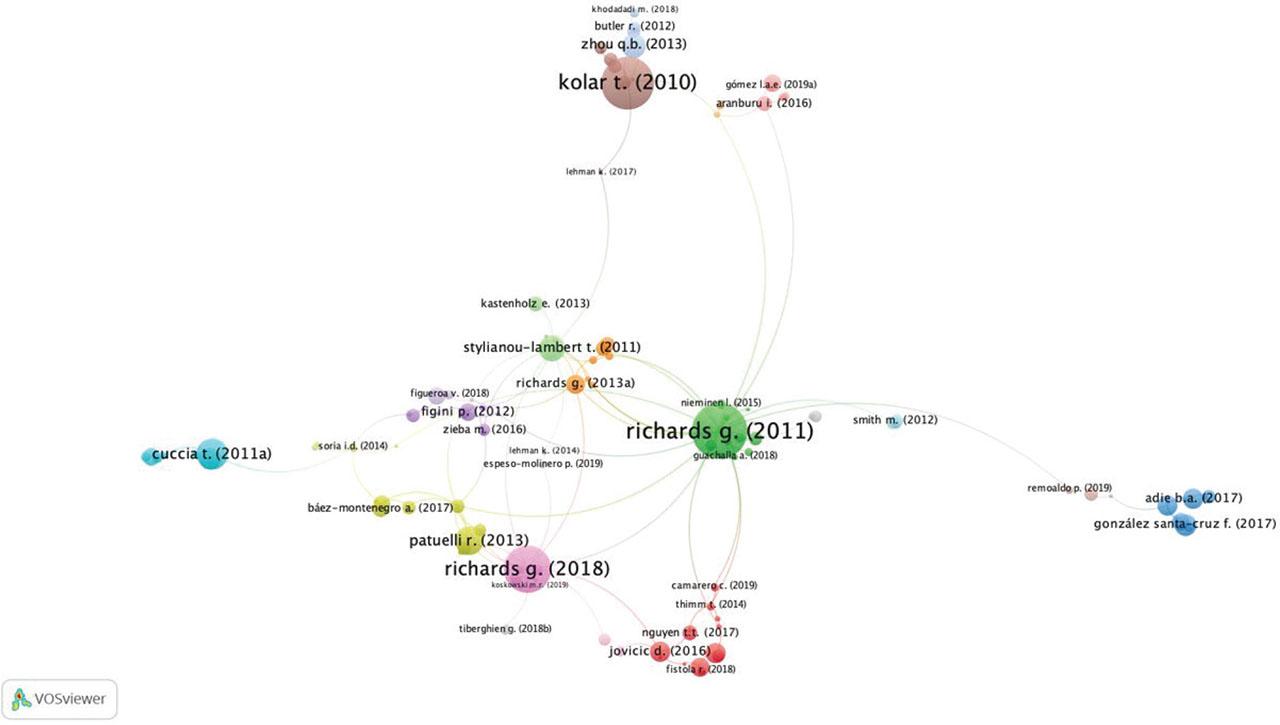
Bibliographic analysis of most cited documents in Scopus
To better clarify these links, Table 3 lists the seven authors with the highest number of citations, indicating the year of publication and the main topic, which can be also associated with the cluster colour. As in the WoS analysis, Richards is prominent in Scopus as well, and Kolar as the second one, but here Salazar appears, with community-based cultural tourism, and Cuccia on seasonality in cultural tourism.
Most Cited Authors About Cultural Tourism in Scopus
| Authors | Citations | Year | Cultural Tourism Topics |
|---|---|---|---|
| Kolar, T. | 457 | 2010 | Authenticity |
| Richards, G. | 518 | 2011 | Creativity and tourism |
| Cuccia, T. | 159 | 2011 | Seasonality |
| Salazar, N. | 203 | 2012 | Community-based cultural tourism |
| Lozano-Oyola, M. et al. | 177 | 2012 | Sustainable tourism indicators |
| Cevdet, M. et al. | 146 | 2015 | Tourist experience |
| García-Hernández, M. et al | 193 | 2017 | Cultural heritage and urban tourism |
Figure 10 is a co-citation analysis map of authors from WoS, where some clusters are strongly apparent. The graph makes it possible identify the founders of theories or paradigms by colouring the similarities in publication and the number of citations in which authors have used the term cultural tourism. Richards, the leader, appears to have a substantial influence over other top researchers in specific themes on cultural tourism, such as McKercher, UNESCO and Timothy.
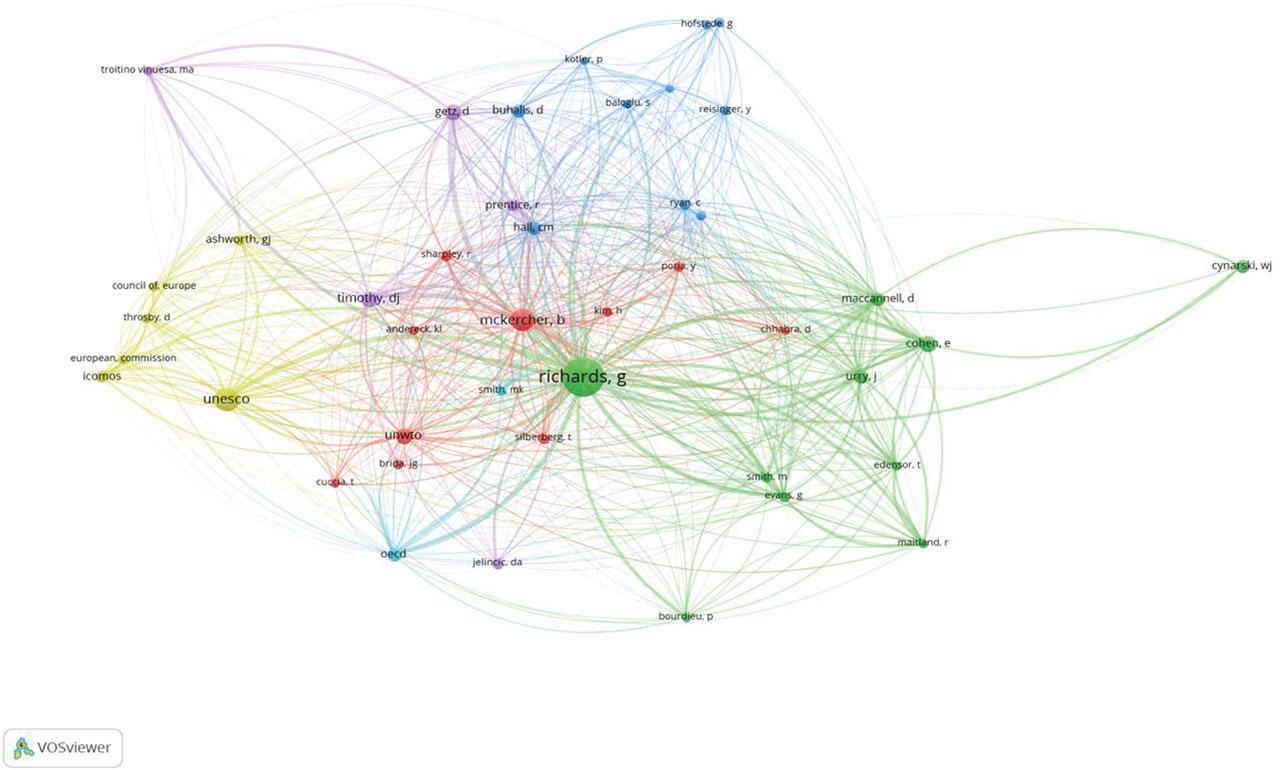
Map of co-citations of authors on cultural tourism from Web of Science
Figure 11 illustrates the co-citation analysis for Scopus, where the findings reveal that the citations are remarkably connected. Richards is also outstanding, but other linked authors emerge as leaders of clusters, such as Urry, Getz and Buhalis. The colours highlight the similarity of subjects: creativity tourism in yellow, heritage in red, urban tourism in blue and cultural policies in green.
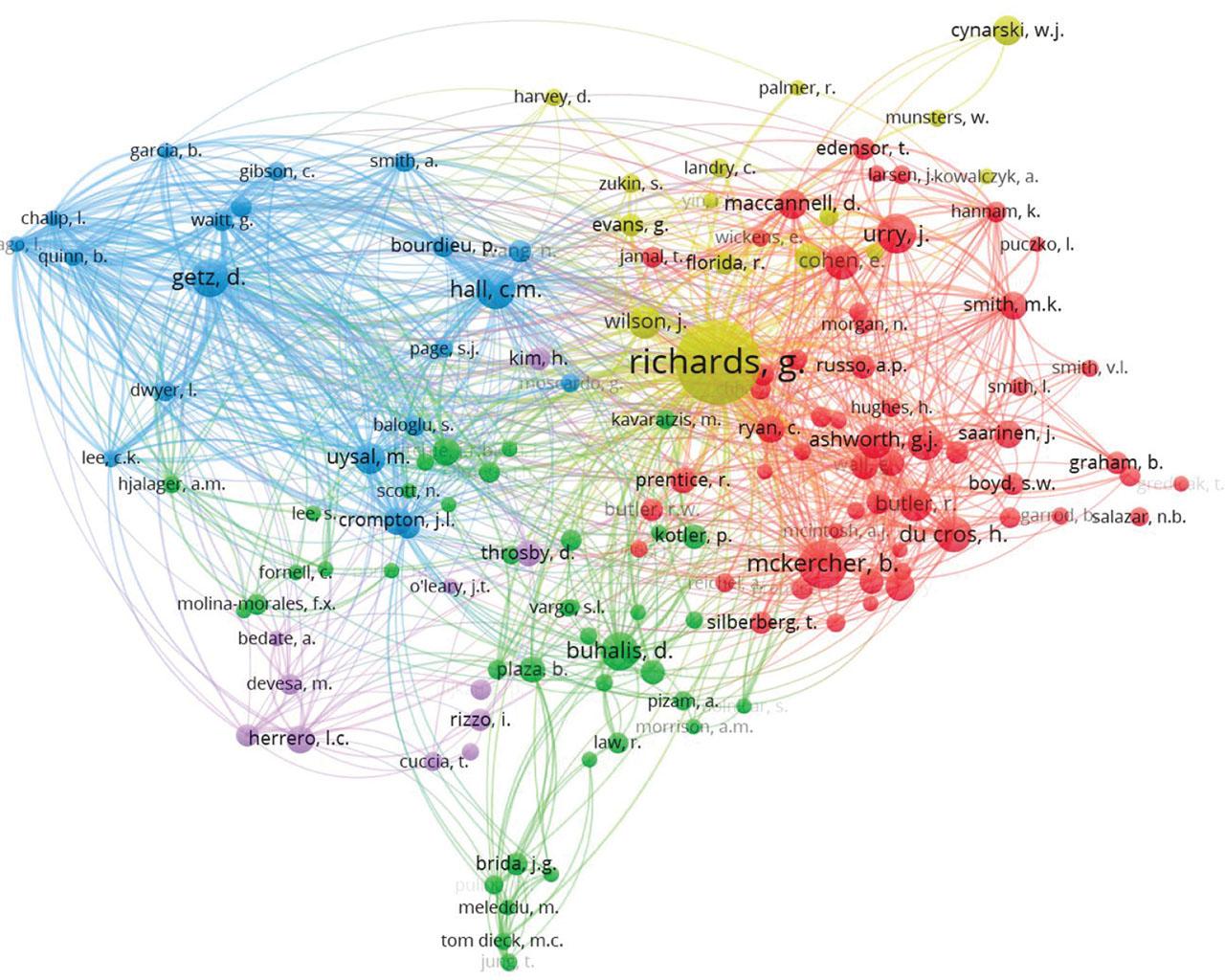
Map of co-citations of authors on cultural tourism from Scopus
Figure 12 illustrates the co-occurrence analysis conducted on the publications from the WoS database. The applied criteria included a minimum of 10 appearances to identify the terms involved with cultural tourism based on the reviewed documents. Four categories could be identified: sustainability, creativity, authenticity and competitiveness. Heritage, cultural landscape and perception and tourism development converge in the first category as key elements of sustainability. Creativity includes experience, whereas the authenticity includes social media, identity and globalisation as a whole. Competitiveness encompasses tourism policies, demand, conservation, consumption and satisfaction, all of which are significant variables of the attraction to destinations.
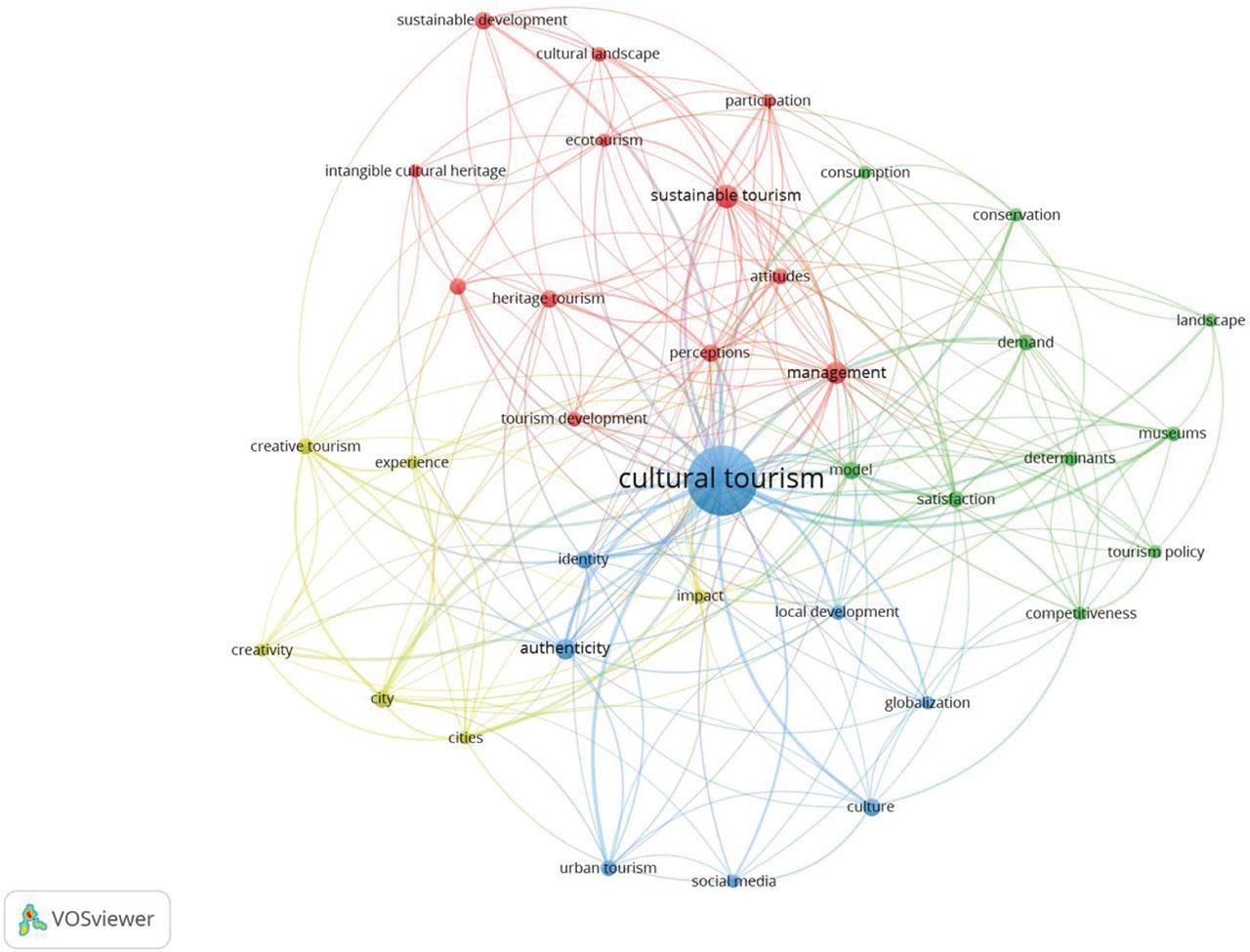
Co-occurrence analysis of keywords in articles on cultural tourism on Web of Science
The co-occurrence analysis of keywords from Scopus was carried out with a minimum of 10 appearances. Figure 13 illustrates the three categories recognised in Scopus: sustainability, authenticity and creativity, with the last including the introduction of technology with terms such as augmented and virtual reality.
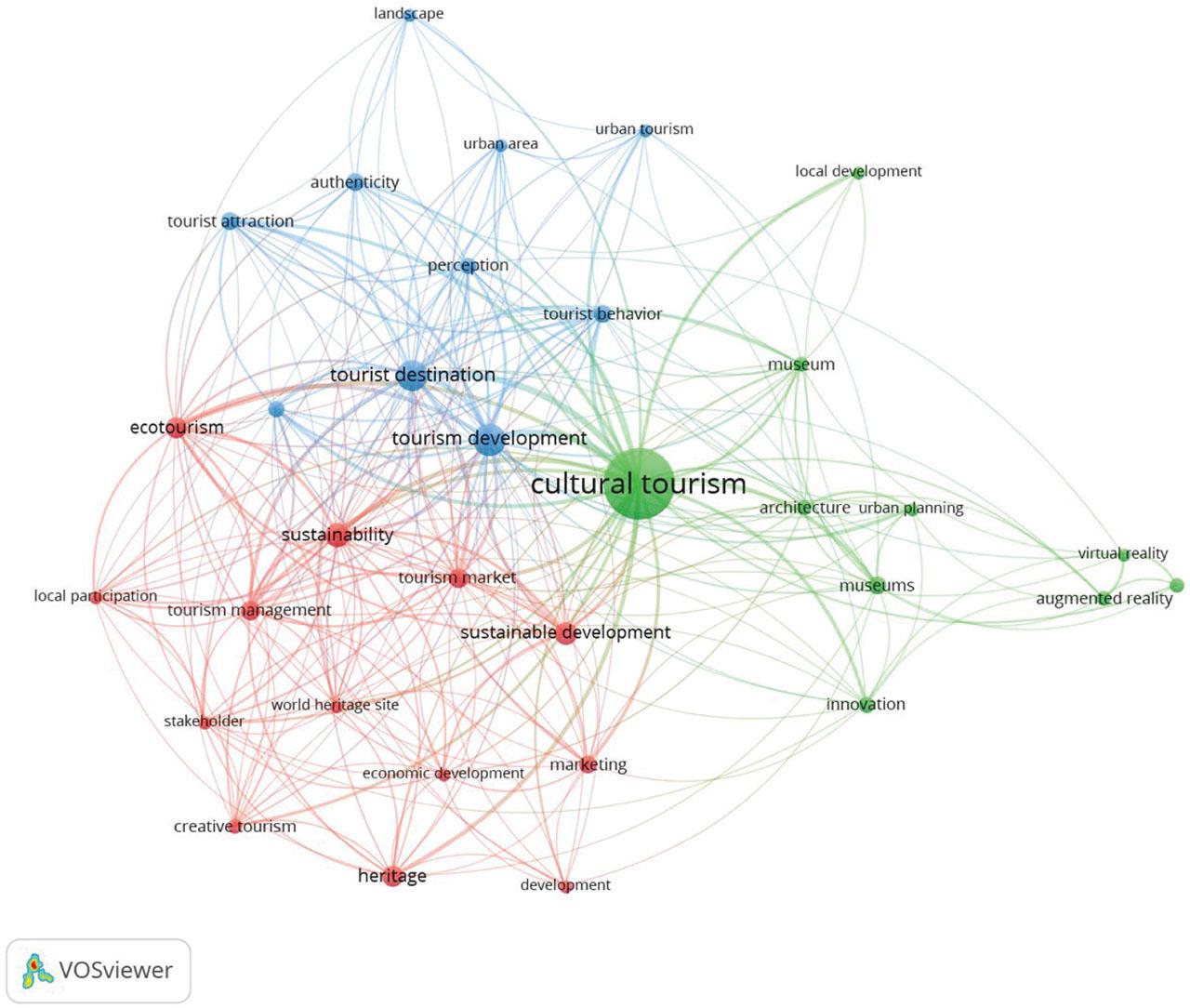
Co-occurrence analysis of keywords in articles on cultural tourism in Scopuss
Finally, this document illustrates the results of the analysis of the main collaborations between individuals and organisations from different countries related to cultural tourism publications, which revealed countries clusters where this research term is meaningful. In WoS, England has the greatest presence and links with others, which indicates high levels of contribution to the research about this term, as shown in Figure 14. In Scopus, however, Spain leads the collaborative publications, followed by the United Kingdom and Italy, which means that they are the most focused on cultural tourism, as displayed in Figure 15.
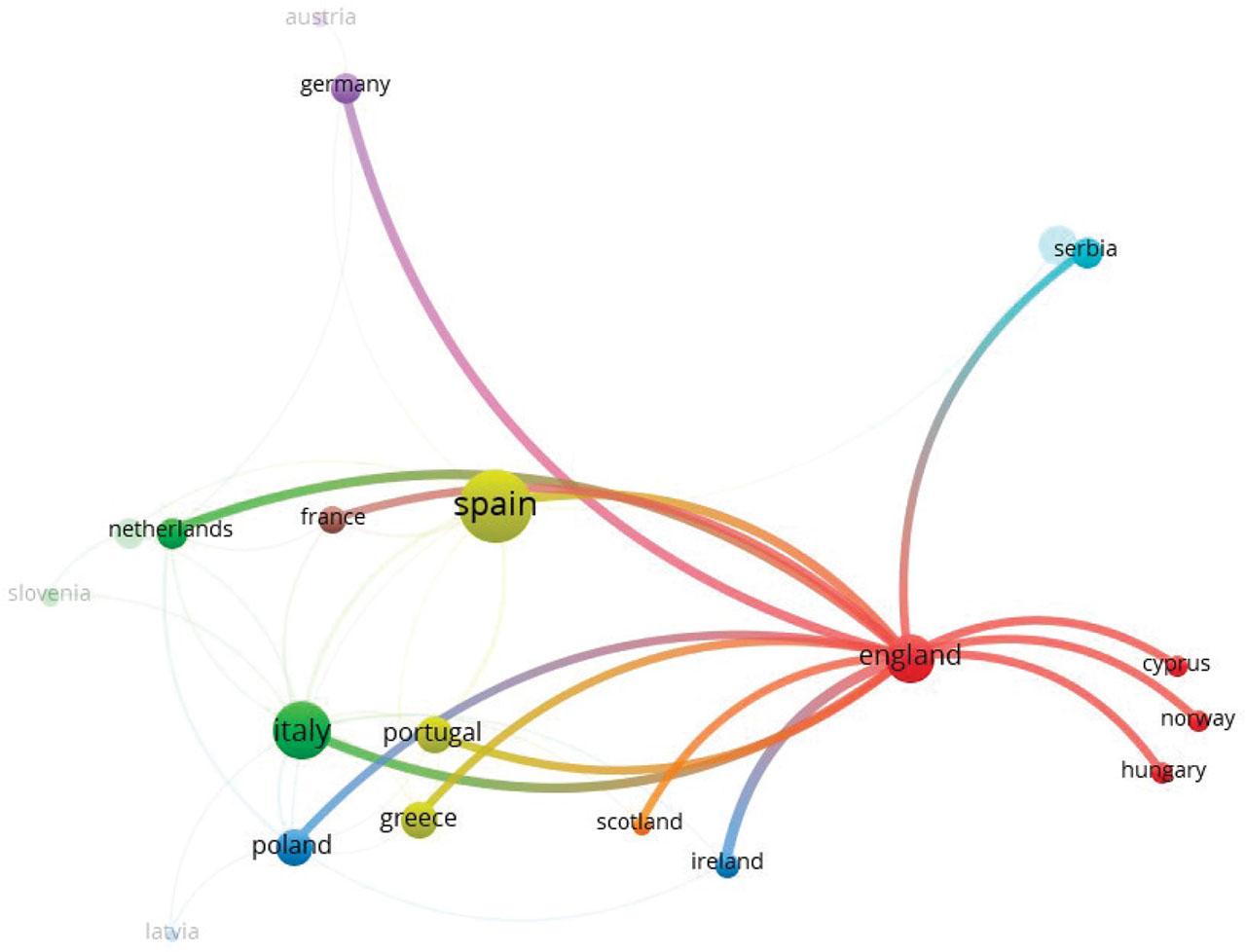
Co-authorship analysis by country in articles on cultural tourism in Web of Science
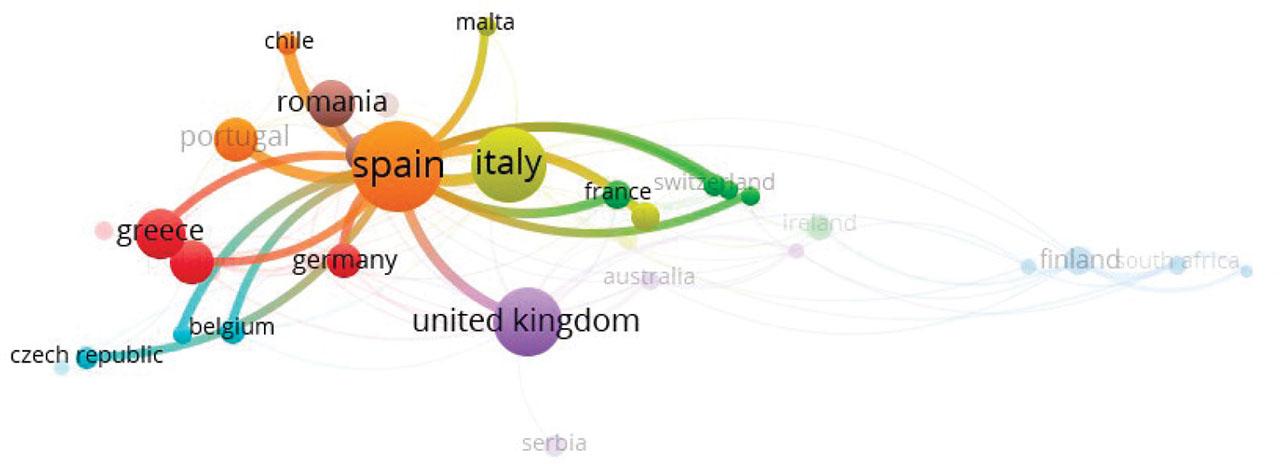
Co-authorship analysis by country in articles on cultural tourism in Scopus
Cultural tourism has achieved broader relevance in the last decade and has come to encompass more than cultural heritage sites. Globalisation has included technological components such as virtual reality and artificial intelligence to support the cultural components that attract tourists to the cultural environment. Local communities have also become important in research, as the key piece to the development of tourism in a place, where the active participation of the community and acceptance of the visitors are a means to procure sustainable development.
Four categories were identified as trends in research on cultural tourism in the last decade: sustainability, creativity, authenticity and competitiveness. Sustainability is understood as the social, environmental and economic triangulation, and the resulting tourism model proposes the formula for action plans in destinations (Lozano-Oyola et al., 2012). Creativity encompasses design, music, dance, artistic creation, gastronomy, games and all knowledge-based activities that help a destination to be different from traditional destinations (Richards, 2018). Although authenticity can seem similar to the creativity cluster, it can be differentiated as a characteristic inserted in the practices of tourism which has the main aim of improving the tourist experience through the analysis, management and marketing of cultural heritage places (Kolar & Zabkar, 2010). In addition, last but not least, competitiveness approaches those facilities that make a destination attractive and the best choice for tourists (Zhang et al., 2011).
This research has many diverse implications. First, it highlights the dominant authors who have focused on cultural tourism in the decade since 2010. It also illustrates how research has come to include topics that have emerged due to changes in the traditional overview, where keywords such as authenticity and creativity appeared. This means that research on cultural tourism has not followed linear patterns of growth, and disciplines such as sociology, anthropology, psychology and communication have continuously considered the study of tourists and hosts in recent years.
Despite this paper’s leading insights, this research is not exempt from certain limitations. This study did not delve into the evolution of cultural tourism outside Europe. In response to the aims of the study, the studies obtained focused on only one continent before the global pandemic, so it is not possible to assume that the trends identified are the only ones. For example, it should be noted that the COVID-19 pandemic brought about drastic changes in thought and, with it, in research studies, where resilience became the most important term for tourism destinations and, as a result, for publications as well.
Based on the foregoing limitations, future research could be based on the review of cultural tourism after COVID-19, differentiating trends among continents and approaching a comparison of destinations. Studies could also include a deeper analysis of citations to clarify the current influence of the topic in the area, complementing it with other techniques to provide more value.
Finally, this study concludes that there is room to improve tourism research with the development of collaborative research involving the participation of international authors and co-authors, increasing the essential knowledge for cultural tourism and clarifying the reputation, at the highest level, of authors in this area.